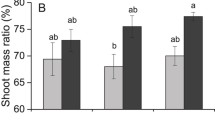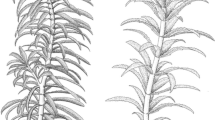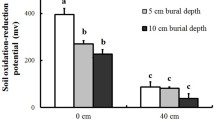Abstract
Shoot status, such as orientation and connection to the root system, and sediment burial depth after flooding disturbances have important ecological consequences on the post-flooding growth and vegetative reproduction of emergent macrophytes in wetlands. In the present study, we investigated the effect of shoot status (vertical, prostrate, or detached) and sediment burial depth (0.5 or 10 cm) on biomass accumulation and propagule production in Phalaris arundinacea (Poaceae) using an outdoor mesocosm system. In contrast to our prediction that shallow sediment burial would activate the axillary buds on prostrate shoots and regenerate more ramets, significantly fewer new ramets, rhizomes, buds, and biomass accumulation formed in P. arundinacea as the shoots changed from vertical to prostrate. Deeper sediment burial resulted in lower biomass and propagule production in plants with prostrate shoots, whereas vertical shoots increased the number of ramets. P arundinacea with detached shoots also produced a number of propagules after shallow or deep sediment burial, which might be important for the long-distance dispersal of P. arundinacea. These results suggest that P. arundinacea is a potentially invasive species in many lacustrine wetlands, particularly those with a high sedimentation rate, due to its high capacity for vegetative propagation.


Similar content being viewed by others
References
Atapattu SS, Kodituwakku DC (2009) Agriculture in South Asia and its implications on downstream health and sustainability: a review. Agr Water Manage 96:361–373
Chapin FS, Schulze ED, Mooney HA (1990) The ecology and economics of storage in plants. Annu Rev Ecol Syst 21:423–447
Chen XS, Xie YH, Deng ZM, Li F, Hou ZY (2011) A change from phalanx to guerrilla growth form is an effective strategy to acclimate to sedimentation in a wetland sedge species Carex brevicuspis (Cyperaceae). Flora 206:347–350
Clarke PJ, Lawes MJ, Midgley JJ, Lamont BB, Ojeda F, Burrows GE, Enrigt NJ, Knox KJE (2013) Resprouting as a key functional trait: how buds, protection and resources drive persistence after fire. New Phytol 197:19–35
Combroux I, Bornette G, Willby NJ, Amoros C (2001) Regenerative strategies of aquatic plants in disturbed habitats: the role of the propagule bank. Arch Hydrobiol 152:215–235
Cui LJ, Gao CJ, Zhao XS, Ma QM, Zhang MY, Li W, Song HT, Wang YF, Li SN, Yan Z (2013) Dynamics of the lakes in the middle and lower reaches of the Yangtze River basin, China, since late nineteenth century. Environ Monit Assess 185:4005–4018
Decruyenaere JG, Holt JS (2001) Seasonality of clonal propagation in giant reed. Weed Sci 49:760–767
Deng ZF, An SQ, Zhao CJ, Chen L, Zhou CF, Zhi YB, Li HL (2008) Sediment burial stimulates the growth and propagule production of Spartina alterniflora Loisel. Estuar Coast Shelf Sci 76:818–826
Deng ZM, Chen XS, Xie YH, Li Xu, Pan Y, Li F (2013) Effects of size and vertical distribution of buds on sprouting and plant growth of the clonal emergent macrophytes Miscanthus sacchariflorus (Poaceae). Aquat Bot 104:121–126
Dong BC, Zhang MX, Alpert P, Lei GC, Yu FH (2010) Effects of orientation on survival and growth of small fragments of the invasive, clonal plant Alternanthera philoxeroides. PLoS ONE 5(10):e13631. doi:10.1371/journal.pone.0013631
Galatowitsch SM, Anderson NO, Ascher PD (1999) Invasiveness in wetland plants in temperate North America. Wetlands 19:733–755
Gilbert ME, Pammenter NW, Ripley BS (2011) Do partially buried dune plants grow in optimal trajectories? Plant Ecol 212:1263–1274
Herr-Turoff A, Zedler JB (2007) Does morphological plasticity of the Phalaris arundinacea canopy increase invasiveness? Plant Ecol 193:265–277
Hou ZY, Chen XS, Xie YH, Li X (2012) Characteristics of soil seed bank and its relationship with aboveground vegetation in Lake Dongting. J Lake Sci 24:287–293 (in Chinese with English abstract)
Kercher SM, Zedler JB (2004) Multiple disturbances accelerate invasion of reed canary grass (Phalaris arundinacea L.) in a mesocosm study. Oecologia 138:455–464
Klimeš L, Klimesová J, Osbornová J (1993) Regeneration capacity and carbohydrate reserves in a clonal plant Rumex alpinus: effect of burial. Vegetatio 109:153–160
Li F, Xie YH (2009) Spacer elongation and plagiotropic growth are the primary clonal strategies used by Vallisneria spiralis to acclimate to sedimentation. Aquat Bot 91:219–223
Li JB, Yin H, Lu CZ, Mao DH, Zhu HP (2008) Impact of sedimentation on Dongting Lake. Acta Geograph Sin 63:514–523 (in Chinese with English abstract)
Madsen TV, Eichler LW, Boylen CW (1988) Vegetative spread of Eurasian watermilfoi in Lake George, New York. J Aaqut Plant Manage 26:47–50
Maun MA (1996) The effects of burial by sand on survival and growth of Calamovilfa longifolia. Ecoscience 3:98–100
Maun MA (1998) Adaptation of plants to burial in coastal sand dunes. Can J Bot 76:713–738
Mou XJ, Sun ZG (2011) Effects of sediment burial disturbance on seedling emergence and growth of Suaeda salsa in the tidal wetlands of the Yellow River estuary. J Exp Mar Biol Ecol 409:99–106
Nzunda EF, Griffiths ME, Lawes MJ (2008) Sprouting by remobilization of above-ground resources ensures persistence after disturbance of coastal dune forest trees. Funct Ecol 22:577–582
Paveglio FL, Kilbride KM (2000) Response of vegetation to control of reed canary grass in seasonally managed wetlands of southwestern Washington. Wildlife Soc Bull 28:730–740
Perumal VJ, Maun MA (2006) Ecophysiological response of dune species to experimental burial under field and controlled conditions. Plant Ecol 184:89–104
Riis T, Madsen TV, Sennels RSH (2009) Regeneration, colonization and growth rates of all fragments in four common stream plants. Aquat Bot 90:209–212
Song YB, Yu FH, Li JM, Keser LH, Fischer M, Dong M, van Kleunen M (2013) Plant invasiveness is not linked to the capacity of regeneration from small fragments: an experimental test with 39 stoloniferous species. Biol Invasions 15:1367–1376
Thomas RG, Hay MJ (2010) The role of nodal roots in prostrate clonal herbs: ‘phalanx’ versus ‘guerrilla’. Evol Ecol 24:1489–1504
Wijte AHBM, Mizutani T, Motamed ER, Merryfield ML, Miller DE, Alexander DE (2005) Temperature and endogenous factors cause seasonal patterns in rooting by stem fragments of the invasive giant reed, Arundo donax (Poaceae). Int J Plant Sci 166:507–517
Wu ZL, Phillips S (2006) Phalaris Linnaeus, Sp. Pl. 1:54. 1753. Flora of China 22:335–336
Zedler JB, Kercher S (2004) Causes and consequences of invasive plants in wetlands: opportunities, opportunists, and outcomes. Crit Rev Plant Sci 23:431–452
Acknowledgement
This study was supported by the S&T Basic Work Program of the Ministry of Science and Technology of China (2013FY111800), the Knowledge Innovation Program of the Chinese Academy of Sciences (ISACX-LYQY-QN-1207), the National Natural Science Foundation of China (31000143), and the Hunan Provincial Natural Science Foundation of China (14JJ2137).
Author information
Authors and Affiliations
Corresponding author
Additional information
Handling Editor: Piet Spaak.
Electronic supplementary material
Below is the link to the electronic supplementary material.
Rights and permissions
About this article
Cite this article
Chen, X., Deng, Z., Xie, Y. et al. Effects of sediment burial disturbance on the vegetative propagation of Phalaris arundinacea with different shoot statuses. Aquat Ecol 48, 409–416 (2014). https://doi.org/10.1007/s10452-014-9493-0
Received:
Accepted:
Published:
Issue Date:
DOI: https://doi.org/10.1007/s10452-014-9493-0




